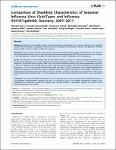Comparison of Shedding Characteristics of Seasonal Influenza Virus (Sub)Types and Influenza A(H1N1)pdm09; Germany, 2007–2011
Süß, Thorsten
Remschmidt, Cornelius
Schink, Susanne
Schweiger, Brunhilde
Heider, Alla
Milde, Jeanette
Nitsche, Andreas
Schroeder, Kati
Döllinger, Jörg
Braun, Christian
Haas, Walter
Krause, Gérard
Buchholz, Udo
Background: Influenza viral shedding studies provide fundamental information for preventive strategies and modelling exercises. We conducted a prospective household study to investigate viral shedding in seasonal and pandemic influenza between 2007 and 2011 in Berlin and Munich, Germany. Methods: Study physicians recruited index patients and their household members. Serial nasal specimens were obtained from all household members over at least eight days and tested quantitatively by qRT-PCR for the influenza virus (sub)type of the index patient. A subset of samples was also tested by viral culture. Symptoms were recorded daily. Results: We recruited 122 index patients and 320 household contacts, of which 67 became secondary household cases. Among all 189 influenza cases, 12 were infected with seasonal/prepandemic influenza A(H1N1), 19 with A(H3N2), 60 with influenza B, and 98 with A(H1N1)pdm09. Nine (14%) of 65 non-vaccinated secondary cases were asymptomatic/subclinical (0 (0%) of 21 children, 9 (21%) of 44 adults; p = 0.03). Viral load among patients with influenza-like illness (ILI) peaked on illness days 1, 2 or 3 for all (sub)types and declined steadily until days 7–9. Clinical symptom scores roughly paralleled viral shedding dynamics. On the first day prior to symptom onset 30% (12/40) of specimens were positive. Viral load in 6 asymptomatic/subclinical patients was similar to that in ILI-patients. Duration of infectiousness as measured by viral culture lasted approximately until illness days 4–6. Viral load did not seem to be influenced by antiviral therapy, age or vaccination status. Conclusion: Asymptomatic/subclinical infections occur infrequently, but may be associated with substantial amounts of viral shedding. Presymptomatic shedding may arise in one third of cases, and shedding characteristics appear to be independent of (seasonal or pandemic) (sub)type, age, antiviral therapy or vaccination; however the power to find moderate differences was limited.
Dateien zu dieser Publikation
Keine Lizenzangabe

